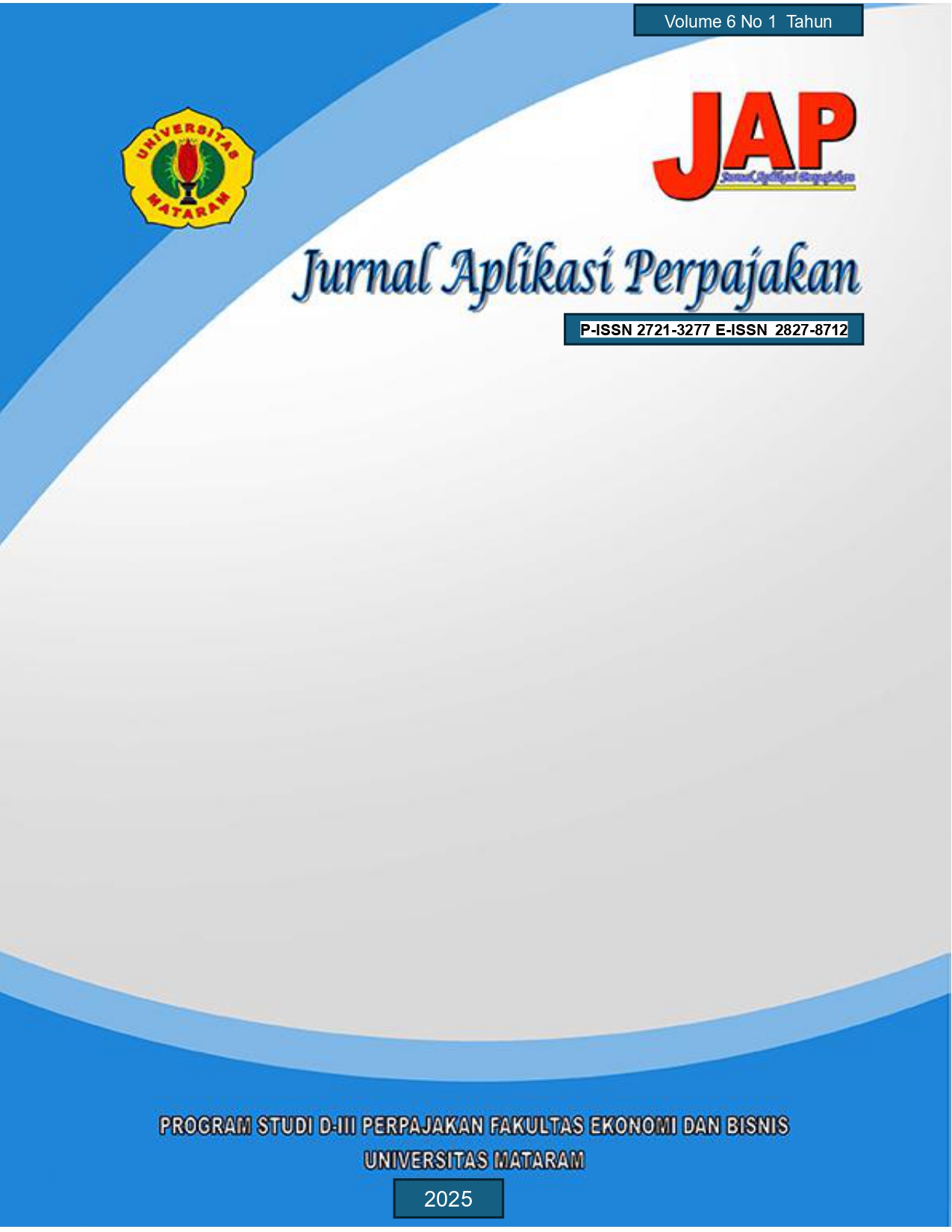Evaluasi Kualitas Aplikasi DJP Online Terhadap Kepuasan Pengguna Dengan Metode EUCS Dan IPA
Main Article Content
Abstract
Along with the digitalization of public services, the DJP Online application has become an important tool for taxpayers, especially MSMEs, in fulfilling their tax obligations. This study aims to evaluate the level of satisfaction of DJP Online application users, especially MSMEs, using the End-User Computing Satisfaction (EUCS) and Importance Performance Analysis (IPA) methods. The objects of this study were 120 MSME taxpayers in the West Java III Regional Office, namely Bogor City, Depok City, Bekasi City and Bogor Regency. This study uses the EUCS method to determine the attributes of the research questionnaire. The variables used are content, accuracy, format, ease of use and timeliness. The sampling technique is purposive sampling. The analysis tools used are Validity Test, Reliability Test and Importance Performance Analysis (IPA). IPA is used to calculate data from the questionnaire and find out which attributes need improvement. The results of the study indicate that users of the DJP Online application, especially MSME Taxpayers, are satisfied with the quality of services provided and meet user expectations, but still need to be improved. This can be seen from the average value of the suitability analysis and the Gap value which shows that the existing features and services have met user expectations. The attribute of the EUCS which is the main priority (Quadrant I) is 1, namely C1 (Content variable) containing Information provided in the DJP Online application regarding specific topics, for example: reporting of the UMKM Annual Tax Return is very relevant to my needs as an UMKM taxpayer.
Article Details

This work is licensed under a Creative Commons Attribution-ShareAlike 4.0 International License.
References
Akbar, R. I., Purnama, D. G., & Riyanto, S. (2022). Importance - Performance Analysis Matrix. Nas Media Pustaka.
Arianto, N. (2022). Manajemen Pemasaran (N. Tilova (ed.)). Cipta Media Nusantara.
Astuti, T. P., Elmayati, E., & Hasanah, T. (2022). Analysis of e-Service quality performance at BKPSDM Lubuklinggau web-based using E-Govqual and Importance Perfomance Analysis (IPA) methods. Sinkron : Jurnal Dan Penelitian Sistem Informasi, 7(3), 1017–1027. https://doi.org/10.33395/sinkron.v7i3.11444
Basyir, A., & Safitri, L. (2022). Determinan Kesuksesan Sistem Informasi Core Banking System Dengan Variabel Pendekatan Model Delone Dan Mclean. Jurnal Syntax Admiration, 3(1), 37–51. https://doi.org/https://doi.org/10.46799/jsa.v3i1.370
Candrianto. (2021). Kepuasan Pelanggan Suatu Pengantar. CV Literasi Nusantara Abadi.
Eucs, M. M. (2019). Metode EUCS 2 (sinta 5). 7(1), 1–7.
Hair, J. F., Black, W. C., Babin, B. J., Anderson, R. E., Black, W. C., & Anderson, R. E. (2018). Multivariate Data Analysis. https://doi.org/10.1002/9781119409137.ch4
Hendradewa, A. P. (2017). Perbandingan Metode Evaluasi Usability (Studi Kasus : Penggunaan Perangkat Smartphone). Teknoin, 23(1), 9–18. https://doi.org/10.20885/teknoin.vol23.iss1.art2
Husain, T., & Budiyantara, A. (2018). Analisis End-User Computing Satisfaction (EUCS) Dan WebQual 4.0 Terhadap Kepuasan Pengguna. JATISI (Jurnal Teknik Informatika Dan Sistem Informasi), 4(2), 164–176. https://doi.org/10.35957/jatisi.v4i2.99
Imron, M., & Pratiwi, D. S. R. (2023). Penerapan Metode End - User Computing Satisfaction (EUCS) Untuk Menganalisis Pengaruh Pembelajaran Online Terhadap Kepuasan Siswa. CogITo Smart Journal, 9(1), 135–144. https://doi.org/10.31154/cogito.v9i1.442.135-144
Indrasari, M. (2019). Pemasaran dan Kepuasan Pelanggan. Unitomo Press.
Nadirah, Pramana, A. D. R., & Zari, N. (2022). Metodologi Penelitian Kualitatif, Kuantitatif, Mix Method (Mengelola Penelitian dengan Mendeley dan Nvivo) (Nadirah, A. D. R. Pramana, & N. Zari (eds.)). CV Azka Pustaka.
Pemerintah Indonesia. (2021). Peraturan Pemerintah Republik Indonesia Nomor 07 Tahun 2021 tentang Kemudahan, Pelindungan, dan Pemberdayaan Koperasi dan Usaha Mikro, Kecil, dan Menengah. 086507, 1–121.
Pujana, G., Made Ardwi Pradnyana, I., & Ketut Resika Artha, I. (2023). Analisis Kepuasan Pengguna E-Rapor Menggunakan Metode End-User Computing Satisfaction (Eucs) Di Smp Negeri 1 Sukasada. Kumpulan Artikel Mahasiswa Pendidikan Teknik Informatika (KARMAPATI), 12(1), 57–66. http://ditpsmp.kemdikbud.go.id/erapor/
Putri, D., & Sihotang, F. P. (2022). Penerapan Metode End User Computing Satisfaction (EUCS) Untuk Tingkat Kepuasan Pengguna Aplikasi PLN Mobile di Kota Palembang. MDP Student Conference, 32–38. https://jurnal.mdp.ac.id/index.php/msc/article/view/1660
Qholisa, S. N., & Nudin, S. R. (2023). Analisis Kepuasan Pengguna Aplikasi JConnect Mobile Menggunakan Metode End User Computing Satisfaction (EUCS) dan Importance Performance Analysis (IPA). Journal of Emerging Information Systems and Business Intelligence, 04(02), 77–87.
Restanti, A. S., Astuti, E. Y., Munjiati, M., Nurwijayanti, U., & Widianingtias, S. (2018). Analisis End-User Computing Satisfaction pada Online Public Access Catalogue “Izylib” di Lingkungan Universitas Jenderal Soedirman. Pustabiblia: Journal of Library and Information Science, 1(2), 223. https://doi.org/10.18326/pustabiblia.v1i2.223-238
Riyanto, S., & Putera, A. R. (2022). Metode Riset Penelitian Kesehatan & Sains. In Metode Riset Penelitian Kesehatan & Sains. Deepublish Publisher.
Sugiyono. (2018). Metode Penelitian Kuantitatif, Kualitatif, dan R&D. CV Alfabeta.
Tjiptono, F. (2019). Strategi Pemasaran (4th ed.). ANDI.
Yazid, M. A., Wijoyo, S. H., & Rokhmawati, R. I. (2019). Evaluasi Kualitas Aplikasi Ruangguru terhadap Kepuasan Pengguna Menggunakan Metode EUCS (End-User Computing Satisfaction) dan IPA (Importance Performance Analysis). Jurnal Pengembangan Teknologi Informasi Dan Ilmu Komputer, 3(9), 8496–8505. http://j-ptiik.ub.ac.id

